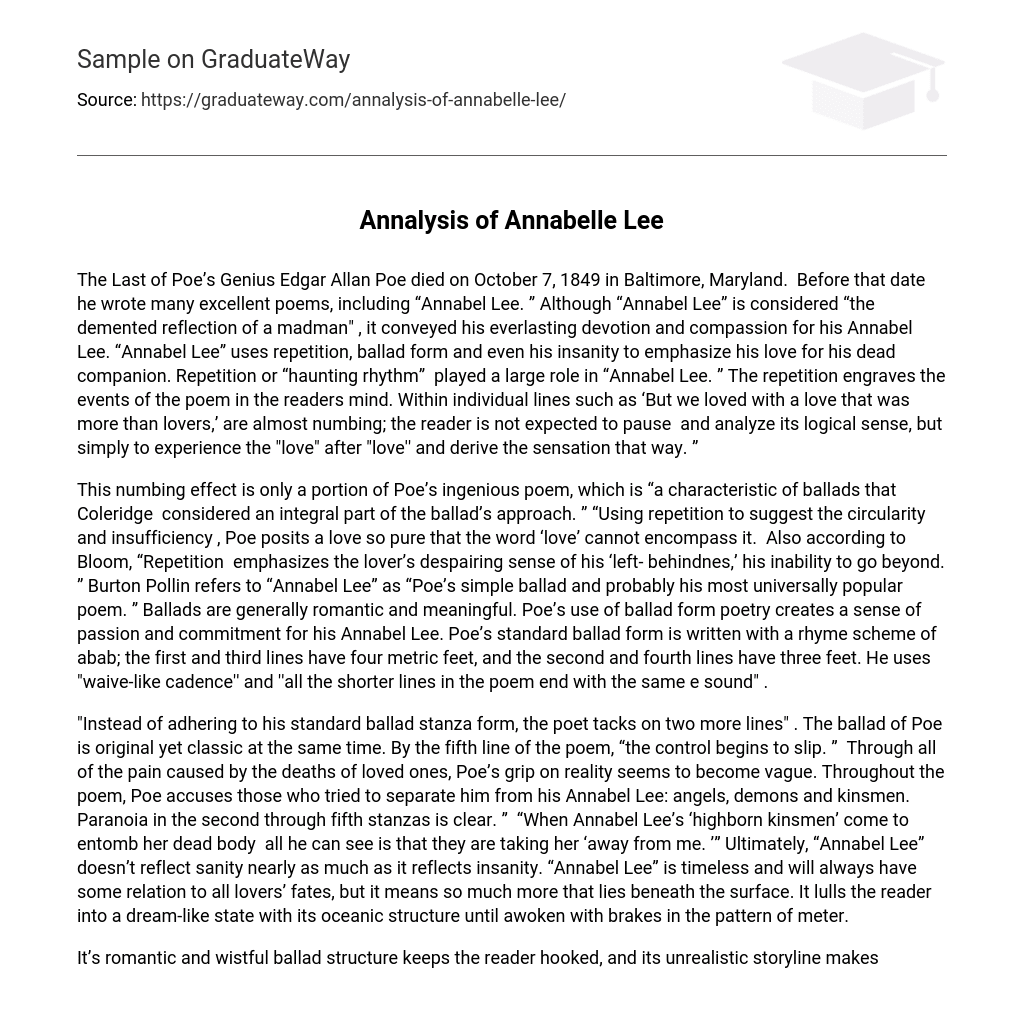The Last of Poe’s Genius Edgar Allan Poe died on October 7, 1849 in Baltimore, Maryland. Before that date he wrote many excellent poems, including “Annabel Lee. ” Although “Annabel Lee” is considered “the demented reflection of a madman” , it conveyed his everlasting devotion and compassion for his Annabel Lee. “Annabel Lee” uses repetition, ballad form and even his insanity to emphasize his love for his dead companion. Repetition or “haunting rhythm” played a large role in “Annabel Lee. ” The repetition engraves the events of the poem in the readers mind. Within individual lines such as ‘But we loved with a love that was more than lovers,’ are almost numbing; the reader is not expected to pause and analyze its logical sense, but simply to experience the “love” after “love” and derive the sensation that way. ”
This numbing effect is only a portion of Poe’s ingenious poem, which is “a characteristic of ballads that Coleridge considered an integral part of the ballad’s approach. ” “Using repetition to suggest the circularity and insufficiency , Poe posits a love so pure that the word ‘love’ cannot encompass it. Also according to Bloom, “Repetition emphasizes the lover’s despairing sense of his ‘left- behindnes,’ his inability to go beyond. ” Burton Pollin refers to “Annabel Lee” as “Poe’s simple ballad and probably his most universally popular poem. ” Ballads are generally romantic and meaningful. Poe’s use of ballad form poetry creates a sense of passion and commitment for his Annabel Lee. Poe’s standard ballad form is written with a rhyme scheme of abab; the first and third lines have four metric feet, and the second and fourth lines have three feet. He uses “waive-like cadence” and ”all the shorter lines in the poem end with the same e sound” .
“Instead of adhering to his standard ballad stanza form, the poet tacks on two more lines” . The ballad of Poe is original yet classic at the same time. By the fifth line of the poem, “the control begins to slip. ” Through all of the pain caused by the deaths of loved ones, Poe’s grip on reality seems to become vague. Throughout the poem, Poe accuses those who tried to separate him from his Annabel Lee: angels, demons and kinsmen. Paranoia in the second through fifth stanzas is clear. ” “When Annabel Lee’s ‘highborn kinsmen’ come to entomb her dead body all he can see is that they are taking her ‘away from me. ’” Ultimately, “Annabel Lee” doesn’t reflect sanity nearly as much as it reflects insanity. “Annabel Lee” is timeless and will always have some relation to all lovers’ fates, but it means so much more that lies beneath the surface. It lulls the reader into a dream-like state with its oceanic structure until awoken with brakes in the pattern of meter.
It’s romantic and wistful ballad structure keeps the reader hooked, and its unrealistic storyline makes it that much more intriguing. “Annabel Lee” by Edgar Allan Poe is an insane, romantic, and lulling piece of literature.
Bibliography
- Bily, Cynthia A. “Annabel Lee Essay” Masterplots II: Poetry, Revised Edition. Salem Press, Inc. 2002
- Bloom, Harold “Thematic Analysis of ‘Annabel Lee’” Bloom’s Major Poets:Edgar Allan Poe Harold Bloom. Infobase Publishing, 1999. 73-76.
- Pollin, Burton R. “Traces in ‘Annabel Lee’ of Allan Cunningham’s Poem” American Notes & Queries May/June 1984: 133-135





